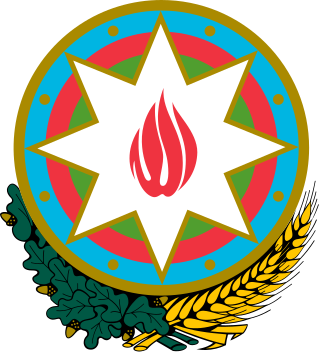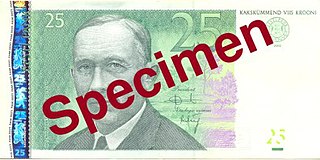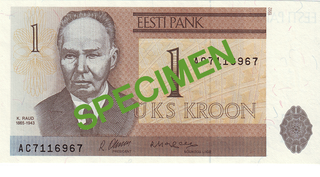
The economy of Estonia is rated advanced by the World Bank, i.e. with high quality of life and advanced infrastructure relative to less industrialized nations. Estonia is a member of the European Union and eurozone. The economy is heavily influenced by developments in the Finnish and Swedish economies.

The kroon was the official currency of Estonia for two periods in history: 1928–1940 and 1992–2011. Between 1 January and 14 January 2011, the kroon circulated together with the euro, after which the euro became the sole legal tender in Estonia. The kroon was subdivided into 100 cents.

In public finance, a currency board is a monetary authority which is required to maintain a fixed exchange rate with a foreign currency. This policy objective requires the conventional objectives of a central bank to be subordinated to the exchange rate target. In colonial administration, currency boards were popular because of the advantages of printing appropriate denominations for local conditions, and it also benefited the colony with the seigniorage revenue. However, after World War II many independent countries preferred to have central banks and independent currencies.

The Lithuanian litas (ISO currency code LTL, symbolized as Lt; plural litai or litų was the currency of Lithuania, until 1 January 2015, when it was replaced by the euro. It was divided into 100 centų. The litas was first introduced on 2 October 1922 after World War I, when Lithuania declared independence, and was reintroduced on 25 June 1993 following a period of currency exchange from the Soviet ruble to the litas with the temporary talonas then in place. The name was modeled after the name of the country. From 1994 to 2002, the litas was pegged to the U.S. dollar at the rate of 4 to 1. The litas was pegged to the euro at the rate of 3.4528 to 1 since 2002. The euro was expected to replace the litas by 1 January 2007, but persistent high inflation and the economic crisis delayed the switch.
Foreign exchange reserves are cash and other reserve assets such as gold held by a central bank or other monetary authority that are primarily available to balance payments of the country, influence the foreign exchange rate of its currency, and to maintain confidence in financial markets. Reserves are held in one or more reserve currencies, nowadays mostly the United States dollar and to a lesser extent the euro.

The Estonian mark was the currency of Estonia between 1918 and 1928. It was running parallel with payment notes from the Clearing House of Tallinn as there was lack of cash in Estonia. The last available payment notes were exchanged for marks in 1923. On 11 November 1918 the Estonian Provisional Government assembled after the Armistice to discuss, among other issues, financial questions and on 30 November 1918 the Provisional Government agreed to establish the Estonian mark. The currency was modeled after Germany as Estonian finances were influenced by German law in 1918. It was initially equivalent to the German ostmark, which had been circulating alongside the Imperial rouble since the German occupation. It was divided into 100 penns.

The Eurosystem is the monetary authority of the eurozone, the collective of European Union member states that have adopted the euro as their sole official currency. The European Central Bank (ECB) has, under Article 16 of its Statute, the exclusive right to authorise the issuance of euro banknotes. Member states can issue euro coins, but the amount must be authorised by the ECB beforehand.

Rein Otsason was an Estonian banker.

The Russian financial crisis began in Russia on 17 August 1998. It resulted in the Russian government and the Russian Central Bank devaluing the ruble and defaulting on its debt. The crisis had severe impacts on the economies of many neighboring countries.

The Central Bank of Azerbaijan is the central bank of Azerbaijan Republic. The headquarters of the bank is located in the capital city Baku.

The Central Bank of Armenia is the central bank of Armenia with its headquarters in Yerevan. The CBA is an independent institution responsible for issuing all banknotes and coins in the country, overseeing and regulating the banking sector and keeping the government's currency reserves. The CBA is also the sole owner of the Armenian Mint.

The 500 krooni banknote is a denomination of the Estonian kroon, the former currency of Estonia. Carl Robert Jakobson (1841–1882), who was an Estonian politician, publisher, writer and promoter of agriculture, is featured on the front side of the bill, which is why the 500 krooni bill is often called a "Jakobson".

The 50 krooni banknote is a denomination of the Estonian kroon, the former currency of Estonia. A portrait of Rudolf Tobias (1873–1918), a famous Estonian composer, is engraved on the front side of the bill along with the pipe organ of the Käina church.

The 25 krooni banknote is a denomination of the Estonian kroon, the former currency of Estonia. A. H. Tammsaare (1870–1940), who was a famous Estonian writer of classical literature, is featured on the front side of the bill, which is why the 25 krooni banknote is often called a "Tammekas or Tammsaare".

The 2 krooni banknote is a denomination of the Estonian kroon, the former currency of Estonia. Karl Ernst von Baer, who was an Estonian Baltic German anthropologist, naturalist and geographer (1792–1876), is featured with a portrait on the obverse. The 2 krooni bill is called sometimes a "kahene" meaning "a two".

The 1 kroon is the smallest valued banknote of the Estonian kroon, the former currency of Estonia. Kristjan Raud (1865–1943), an Estonian painter, teacher, and cultural historian, is featured with a portrait on the obverse. A view of Toompea Castle in Tallinn appears on the reverse.
The 1 kroon coin was put in circulation from 1 August 1934 to 25 March 1941, during the first independence period of Estonia. The exact number of coins minted is not known, as part of the archives was destroyed in the war, but some data indicate that about 3,406,066 pieces were struck. Between 1935 and 1936, 1,586,000 1 kroon coins were minted. Designed by graphic artist Günther Reindorff, it depicts the image of a 13th-century Viking cargo ship.
Banking in Estonia covers banking in Estonia. Banking started with the establishment of the central bank, the Bank of Estonia in 1919. It lost control during the Soviet period when banking was controlled from Moscow by Soviet powers. It was reestablished in 1990. As of 2022 it consists of the central bank and a number of commercial banks providing banking and financial services. Many of the commercial banks operating in Estonia are foreign banks primely from Scandinavia.
Wigla show is an Estonian sketch comedy series created by and featuring Ivar Vigla that aired on Eesti Televisioon from 1989 to 1991 and on Kanal 2 from 1998 to 2000. The Kanal 2 series featured Dan Põldroos, Jan Uuspõld, Egon Nuter, Pille Pürg and Raivo Mets.


















